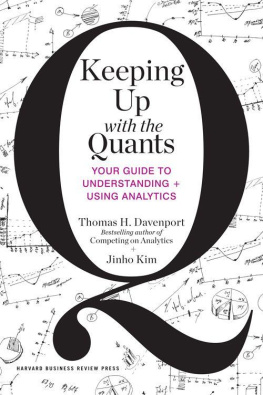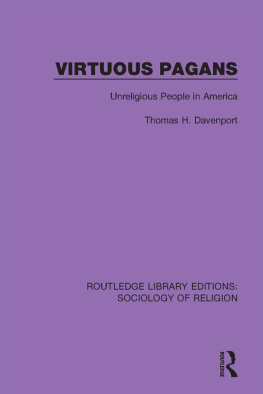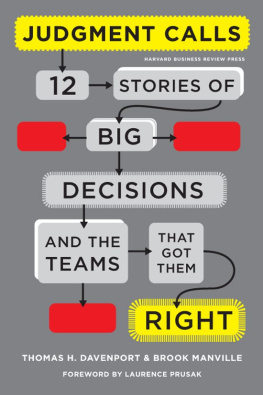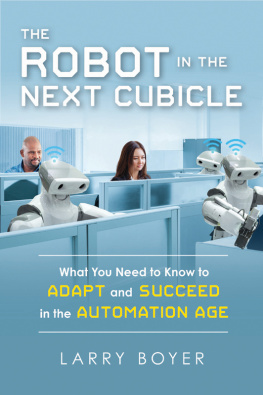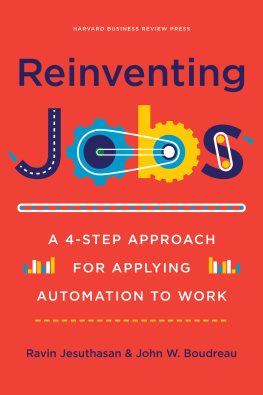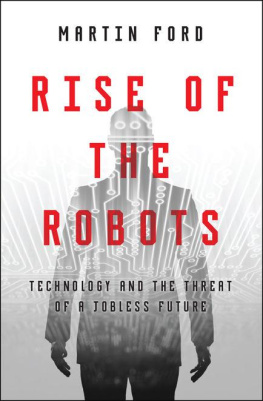
Both of us dedicate this book to our kidsHayes and
Chase in Toms case, and David, Jane, and Ted in Julias.
Julia has confidence that hers, in their very human and
different ways, will make the world a better place. Tom
is similarly sure that his will continue to find interesting
and useful work, and hopes they provide him with
grandchildren so that the theories in this book can be
fully tested over the long run.
CONTENTS
Guide
I n the bucolic outskirts of tiny Talcott, West Virginia, stands a statue of a man who succeededhowever brieflyin beating a machine that threatened to take his job. John Henry, a steel driver working for the Chesapeake & Ohio Railway in 1870, was part of a crew carving a mile-long tunnel through Big Bend Mountain when management brought in a steam-powered drill. Henry said he could outdo the drill and he did, only to die soon after from the exertion. Roadside America, a guide to offbeat tourist attractions, sums things up: As an inspiring tale for the working everyman, his story obviously leaves something to be desired.
We might wonder why it was so important to Henry to beat the machine. There is a bigger question, though: Why does his victory over the machine still resonate with the rest of us? Why the folktale and why the statue? Why do we still teach schoolchildren to sing his ballad?
Anxiety about machines encroaching on the work of people runs deep. Some sixty years before the Great Bend Tunnel, the Luddites (possibly named after an early machine smasher, Ned Ludd) reacted more destructively to the stocking frames, spinning frames, and power looms that were making textile workers redundant. Some eighty years after John Henry, in 1955, Ford Motor Company workers rose up against unprecedented automation of the assembly lines in Brook Park, Ohio. Their wildcat strikes were blessed by local union leader Alfred Granakis, who called the automation of manufacturing an economic Frankenstein.
The aftermath has always been far more positive than folks imagined. We could cite any number of economic studies giving the lie to what economists call the Luddite fallacy. They show that productivity gains have in fact always ledeventually if not immediatelyto more jobs, not fewer. True, many tasks leave the hands of humans, but the technologies simultaneously usher in plenty of new, higher-order tasks for people to do instead. There has always been higher ground to which humans could retreat. Job losses due to skill-biased technical change are therefore real, but temporary. Even today, as an Oxford University study claims that 47 percent of total U.S. jobs are at risk of termination because of computerization in the near future, economists (and plenty of technology vendors) offer assurances that the same will happen again.
But what if, this time around, things play out differently? What if there is no higher ground? Its important to note that the type of work being displaced today is of a different kind than in the past. In fact, we can easily trace three eras of automation, based on the types of work they have brought machines forth to challenge. First, machines relieved humans of work that was manually exhausting and mentally enervating. This was the story of the late industrial revolution, which, having pulled all those workers off farms and into factories, proceeded to make most of them unnecessary with contraptions like the flying shuttle, the spinning jenny, and the power loom. And its a process that continues around the world. Consider Foxconn, the Chinese manufacturing subcontractor to global electronics brands like Apple. Starting in 2011, it started putting robots on the lines to perform welding, polishing, and such tasksten thousand of them that first year. In 2013, Chairman Terry Gou noted at Foxconns annual meeting that the firm now employed over a million people. But, he was quick to add: In the future we will add one million robotic workers.
If that goal is realized, it will mean, of course, that some hundreds of thousands of human workers will never get hireda loss of jobs for the local economy. But at the level of the individual worker, it might feel like less of a loss, because the particular tasks that are being taken away are generally not cherished. In Amazons gargantuan warehouses, for example, its tough for workers to pick and pack customer orders if they have to do the running from one end of the building to anotherso tough that journalists working there undercover have published scathing articles about the inhuman demands placed on them. So now the company uses Kiva Systems (now Amazon Robotics) robots to bring shelves to the workers, allowing humanswho still have strong advantages in spotting the specific items and packing them appropriatelyto stay in one place. Does it make the job easier? Without a doubt. Does it mean Amazon needs fewer people to fulfill a given number of orders? You bet.
The second era of automation followed workers to the higher ground theyd headed for when machines took the grunt work. For the most part, this wasnt the realm of the dirty and dangerous anymore. It was the domain of dull. Think, for example, of the 1960s-era secretary toiling away in a typing pool, translating scribbled or spoken words into neat memos. Some might call this knowledge work, since it calls on brain rather than brawn, but it clearly stops short of decision-making. After computers were invented, it was easy territory for machines to make more productive.
For some secretarial tasks, heres how far that process has gone. In the midst of working on this section, Tom was planning to meet a friend for coffee later in the week. The friend is an independent consultant, so it was slightly surprising to learn, by being ccd on an email, that he employed an assistant, Amy. He wrote:
Hi Amy,
Would you please send an invite for Tom and me for Friday 9/19 at 9:30 A.M. at Hi-Rise Cafe in Cambridge, MA. We will be meeting in person.
Thanks,
Judah
Curiosity getting the best of him, Tom looked up the company in Amys email extension, @x.ai. It turns out X.ai is a company that uses natural language processing software to interpret text and schedule meetings via email. Amy, in other words, is automated. Meanwhile, other tools such as email and voice mail, word processing, online travel sites, and Internet search applications have been chipping away the rest of what used to be a secretarial job.
Era Two automation doesnt only affect office workers. It washes across the entire services-based economy that arose after massive productivity gains wiped out jobs in agriculture, then manufacturing. Many modern jobs are transactional service jobsthat is, they feature people helping customers access what they need from complex business systems. But whether the customer is buying an airline ticket, ordering a meal, or making an appointment, these transactions are so routinized that they are simple to translate into code. You might well know someonea bank teller, an airline reservations clerk, a call center representativewho lost his or her job to the new reality of computerized systems enabling self-service. At least, you feel the absence of them when you contact a company and encounter a machine interface.
Just as Era One of automation continues to play out, so does Era Two. There is still plenty of work currently performed by humans that could be more cheaply and capably performed by machinesincreasingly smart ones in particular. Think, for example, of the loneliness of the long-distance truckera job, by the way, that didnt exist in the early industrialization era but was created by technological progress. Human drivers are still kings of the road, but perhaps not for much longer. Tom recently asked a senior FedEx executive whether he thought that his company would switch anytime soon to self-driving trucks. His casual responseWell, not on the
Next page

